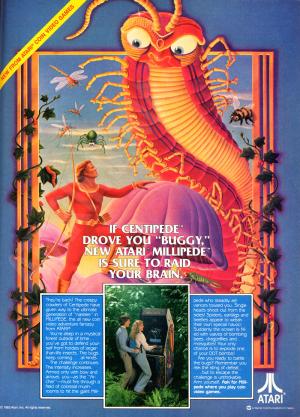

Platform: Arcade
Region: NTSC-U
Country: United States of America
Developer(s): Atari
Publishers(s): Atari, Inc.
ReleaseDate: 1982-11-20
Players: 2
Co-op: No
Millipede
Millipede is a 1982 arcade video game developed and released by Atari in the USA on November 20, 1982. Millipede is the sequel to the 1981 arcade video game, Centipede. The player no longer takes the role of the "Bug Blaster" from Centipede, but instead takes the role of an elf called the "Archer". The object of the game is to destroy a millipede that advances downward from the top of the screen. The millipede travels horizontally until it either hits an obstacle or reaches the edge of the screen, after which it drops one row and reverses direction. Once it enters the player's gray maneuvering area, it stays there and extra heads appear at intervals until both they and the millipede are destroyed. Shooting a body segment splits the millipede in two, with the rear portion sprouting its own head. A collision with any enemy costs the player one life. Differences from Centipede According to the game's arcade flyer and instruction manual, the game's storyline involves the player character, Archer, defending his mushroom forest from the onslaught of gigantic insect monsters using his magic arrows. The millipede moves faster and its head segment is more difficult to hit. Earwigs replace scorpions from Centipede, making mushrooms poisonous so that the millipede will charge straight to the bottom of the screen after touching them. Bees replace fleas from Centipede, leaving mushrooms in a vertical line and requiring two shots to destroy. Spiders behave the same way as in Centipede, moving in zig-zag pattern across the player area and eating mushrooms. Multiple spiders can appear at the same time on higher levels. Inchworms move horizontally across the screen and slow all enemies for a short period of time when hit. Ladybugs crawl around the player area for a while, then climb up and leave the screen, turning any mushrooms they touch into indestructible flowers. When hit, all mushrooms on the screen scroll down one row. Dragonflies drop mushrooms while zig-zagging down. Mosquitoes bounce off the sides of the screen as they descend diagonally. When hit, all mushrooms on the screen scroll up one row. DDT bombs are triggered when shot, destroying all enemies and mushrooms within the resulting cloud. Whenever the mushrooms scroll down, a new bomb is added at the top of the screen, with up to four bombs in play at one time. Points are scored for shooting the bomb itself, and enemies destroyed in the blast are worth three times the normal points. All flowers and poisoned or partially destroyed mushrooms revert to normal, whole mushrooms and score points during the process when the player loses a life. At regular intervals, the player enters a bonus level with a swarm of enemies (bees, dragonflies, etc.) instead of the usual millipede. Each enemy awards increasing points, up to a maximum of 1,000 points per enemy. The attack ends when either the entire swarm has passed or the player loses a life. Also, at intervals new mushrooms will grow on the field while others disappear, in a pattern similar to Conway's Game of Life. Players can choose whether to play at an advanced level, starting with a score that is a multiple of the number of points needed to earn an extra life (by default, 15,000). The gameplay is generally much more advanced than it would be had the player started with a score of 0 and worked their way up to that point level. The maximum advanced level allowed is a function of the preceding player's score, and games started at an advanced level where the player did not earn at least one extra life are not eligible for the high scoreboard.
Trailer: YouTube
ESRB Rating: E - Everyone
Genre(s): Action | Shooter



